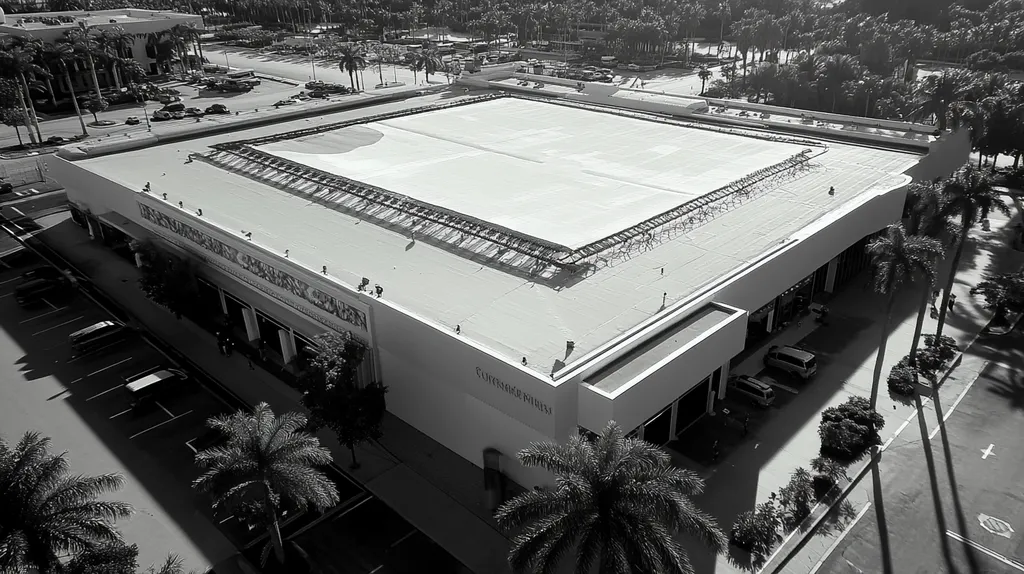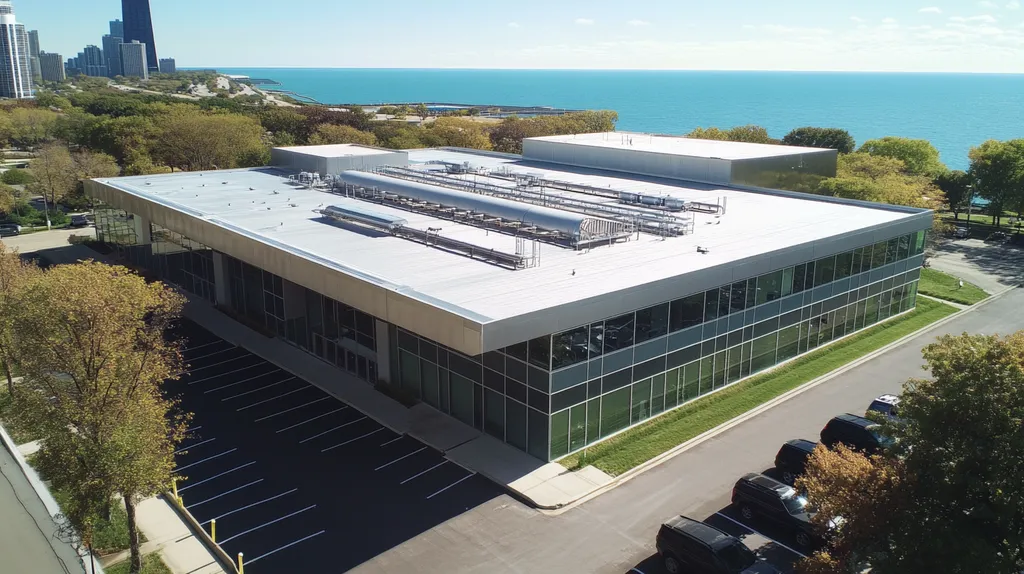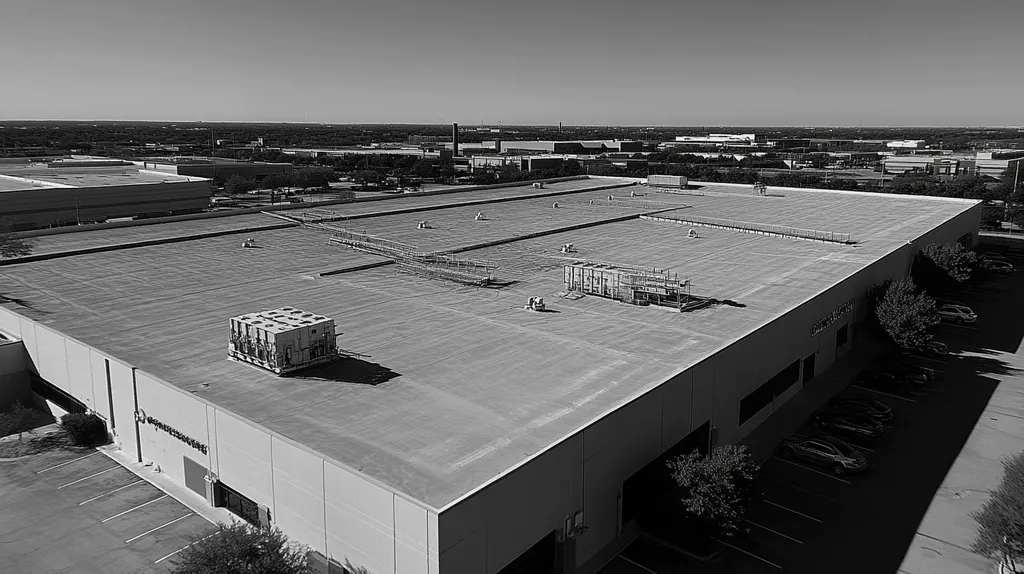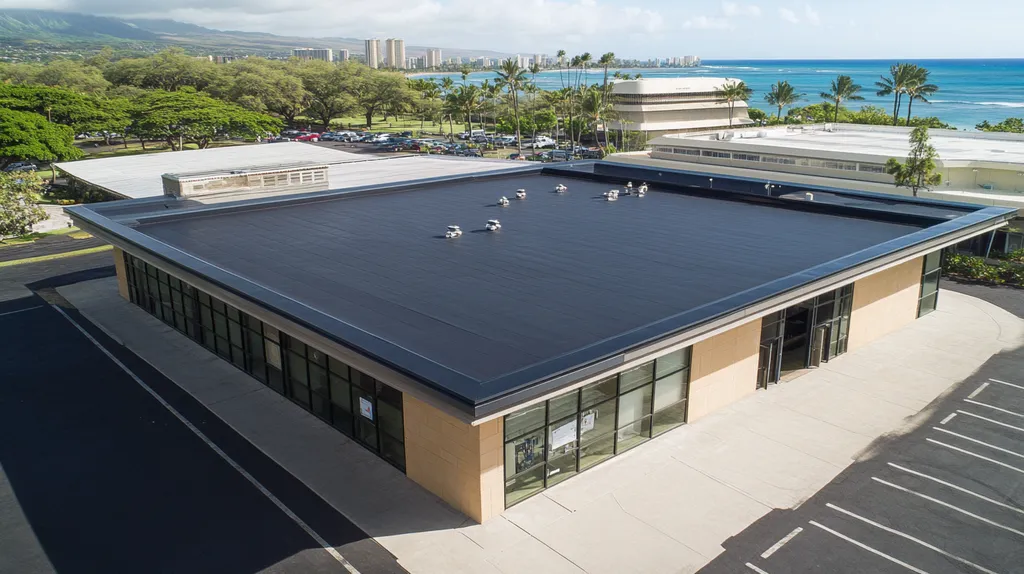Welcome to today’s Battle Royale featuring two roofing heavyweights: “Cool Roofs” in the east corner versus “Green Roofs” in the west!
Tonight’s showdown pits these contenders against each other across six punishing rounds designed to test every aspect of their performance for Eco-Friendly Options for Commercial Roof Projects.
At stake? Millions in potential costs, decades of building protection, and the critical performance demands of modern commercial and industrial facilities.
Our professional judging panel will evaluate each round on technical merit, real-world performance, and value delivery. After all six rounds, we’ll declare our ultimate champion.
Ladies and gentlemen, facility managers and building owners… it’s time to rumble!
ROUND 1: INITIAL COSTS & INSTALLATION
While sustainability buzzwords flood the roofing industry faster than a clogged drain during monsoon season, the rubber meets the road when writing those checks. Property owners facing roof replacement decisions in 2024 must navigate a maze of eco-friendly options that promise everything short of solving world peace. But before getting starry-eyed over glossy brochures, let’s break down the brutal financial reality of cool roofs versus green roofs.
Material Expenses
Cool roofs represent the budget-conscious path to environmental responsibility, with materials typically running $0.75 to $4.00 per square foot. These reflective coatings and membranes don’t require a second mortgage to purchase, making CFOs significantly less likely to break out in cold sweats.
Green roofs, however, demand premium materials that would make a luxury car dealer blush. The complex layering system of waterproofing, root barriers, drainage mats, engineered soil, and carefully selected vegetation pushes costs north of $10 per square foot – and that’s before adding any fancy sustainable bells and whistles.
For property owners who haven’t discovered buried treasure in their parking lot, cool roofs deliver eco-benefits without requiring a GoFundMe campaign. The material cost differential is stark enough to give cool roofs a clear ADVANTAGE in this category.
Installation Complexity
Installing a cool roof basically follows standard roofing procedures, just with specialized reflective materials. Any experienced commercial roofing crew can handle the job without needing a PhD in thermodynamics or a master gardener certificate.
Green roofs, by comparison, transform simple roof replacement into something resembling a botanical garden construction project. The installation requires multiple specialized contractors, precise coordination, and enough technical expertise to make NASA engineers nervous.
Unless you enjoy juggling multiple contractors and watching your timeline spiral into infinity, cool roofs win this round handily. The straightforward installation process gives cool roofs another clear ADVANTAGE.
Project Timeline
Cool roof installations move at the speed of traditional roofing projects. A typical commercial building can go from start to finish in days or weeks, depending on size and complexity.
Green roof timelines stretch longer than a government procurement process. Between structural engineering reviews, specialized material staging, multi-phase installation, and plant establishment periods, these projects often span months.
For building owners who prefer their roof projects finished before the next ice age, cool roofs deliver another decisive ADVANTAGE. The dramatically shorter timeline keeps disruption to a minimum and gets facilities back to normal operations faster.
ROUND 1 WINNER: COOL ROOFS
ROUND 2: DURABILITY & LIFESPAN
When it comes to commercial roofing, longevity isn’t just about lasting – it’s about thriving under brutal conditions. From scorching summer heat to winter’s icy grip, these systems must endure decades of abuse while protecting millions in assets below. The difference between a roof that lasts 15 years versus 50 years can mean hundreds of thousands in lifecycle costs.
Weather Resistance
Cool roofs excel at reflecting solar radiation, which helps prevent heat-related deterioration and UV damage. Their reflective surfaces and specialized membranes create a robust barrier against the elements, particularly in hot climates where traditional roofs take a beating.
However, these systems can struggle in colder regions where snow and ice accumulation become issues. The reflective properties that make them heroes in summer can actually work against them in winter, potentially leading to increased heating costs and moisture concerns.
Green roofs laugh in the face of weather extremes. Their multiple layers and living components actually gain strength from environmental exposure, creating a natural shield that adapts to conditions.
The vegetation and soil layers provide superior insulation against both heat and cold, while simultaneously protecting the underlying waterproofing from UV radiation and temperature swings. Green roofs claim the ADVANTAGE in weather resistance.
Structural Integrity
Cool roofs maintain their structural integrity through relatively simple means – proper installation and periodic recoating. Their lightweight nature puts minimal stress on building structures, and damage is typically easy to spot and repair.
The consistency of cool roof materials means fewer potential failure points. When problems do occur, they’re usually limited to surface issues rather than systemic failures.
Green roofs take structural integrity to another level through their sophisticated layering system. The combination of growing medium, drainage layers, and root barriers creates a remarkably stable environment that actually strengthens over time as plant roots establish themselves.
While more complex, this living armor provides unmatched protection for the underlying structure, earning green roofs another clear ADVANTAGE.
Maintenance Requirements
Cool roofs keep maintenance simple and predictable. Regular inspections, cleaning, and occasional recoating are typically all that’s needed to maintain performance. Most issues can be addressed by standard roofing crews without specialized training.
Green roofs demand more intensive care, requiring both traditional roofing maintenance and horticultural expertise. Regular plant care, irrigation monitoring, and specialized inspections become part of the routine.
Despite higher maintenance demands, green roofs compensate by offering significantly longer lifespans – often exceeding 40 years compared to 15-20 for cool roofs. The investment in maintenance pays off through extended service life.
While maintenance complexity favors cool roofs, the dramatic lifespan advantage of green roofs creates a TIE in this category.
ROUND 2 WINNER: Green Roofs
ROUND 3: PERFORMANCE FACTORS
In the high-stakes world of commercial roofing, performance isn’t just about keeping the rain out anymore. With energy costs soaring faster than a contractor’s insurance premiums and climate regulations tightening like a rusty bolt, choosing the wrong roof system can hemorrhage money faster than a bitcoin crash.
Modern building owners need roofing solutions that deliver measurable returns while satisfying increasingly stringent environmental requirements. The battle between cool roofs and green roofs comes down to hard data, not eco-marketing fluff.
Energy Efficiency
Cool roofs dominate the energy efficiency game through sheer physics. Their highly reflective surfaces bounce back up to 80% of solar radiation, dramatically reducing cooling loads during peak demand periods.
Building owners in hot climates report cooling cost reductions of 15-25% after cool roof installations. The savings are particularly dramatic in single-story commercial buildings where roof heat gain drives HVAC costs.
Green roofs provide insulation benefits through their soil mass and vegetation, but the impact is less direct. While they help moderate temperature swings, they can’t match the immediate cooling effect of reflective surfaces.
For pure energy efficiency impact, especially in cooling-dominated climates, cool roofs claim a clear ADVANTAGE.
Stormwater Management
Cool roofs handle water like any conventional system – get it off the roof as quickly as possible. While effective drainage design can mitigate runoff issues, these systems offer no inherent stormwater management benefits.
Green roofs transform your building’s footprint from an environmental liability into a stormwater management asset. The growing medium and vegetation can retain 50-90% of rainfall, releasing it slowly through natural processes.
This natural retention capacity reduces peak flow rates into municipal systems and helps filter pollutants from rainwater. For properties facing stormwater regulations or seeking LEED certification, this benefit is impossible to ignore.
In the stormwater management arena, green roofs secure an overwhelming ADVANTAGE.
Thermal Performance
Cool roofs excel at reflecting heat but can actually increase winter heating costs in cold climates. Their effectiveness also degrades over time as surfaces accumulate dirt and wear, requiring regular maintenance to maintain peak performance.
Green roofs maintain consistent thermal performance year-round through their natural insulation properties. The soil and vegetation create a dynamic thermal buffer that adapts to seasonal changes.
While both systems can reduce urban heat island effects, green roofs provide additional benefits through evapotranspiration and biodiversity support. However, this comes with higher maintenance requirements and structural considerations.
Given the year-round benefits versus seasonal limitations, green roofs claim the ADVANTAGE in thermal performance.
ROUND 3 WINNER: ADVANTAGE TO GREEN ROOFS
ROUND 4: MAINTENANCE REQUIREMENTS
In the high-stakes world of commercial roofing, maintenance isn’t just a line item – it’s the difference between a 40-year roof and a premature replacement that drains capital reserves. While marketing brochures love to tout “maintenance-free” systems, reality hits harder than a summer hailstorm when that neglected roof starts showing its age.
Property owners face a critical choice: commit to comprehensive maintenance strategies upfront or gamble with increasingly expensive emergency repairs down the road. The maintenance requirements of cool roofs versus green roofs represent radically different approaches to long-term roof care.
Routine Inspection Requirements
Cool roofs demand relatively straightforward inspections focused on surface coating integrity, seam condition, and drainage paths. Most checks can be completed by general maintenance staff with basic training in roof safety protocols.
The inspection schedule typically aligns with standard commercial roof maintenance – semi-annual visual inspections plus detailed annual assessments. Issues tend to be obvious and localized, making documentation and repair planning straightforward.
Green roof inspections require specialized expertise in both roofing and horticulture. Beyond standard roofing concerns, technicians must evaluate soil composition, plant health, irrigation systems, and root barrier integrity.
The complexity and frequency of green roof inspections, combined with the need for multiple specialists, gives cool roofs a clear ADVANTAGE in this category.
Cleaning and Preventive Care
Cool roof maintenance centers on keeping reflective surfaces clean and functional. Regular washing removes dirt and debris that can degrade thermal performance, while spot repairs address minor damage before it spreads.
Most preventive work can be completed using standard pressure washing equipment and basic roofing supplies. The process is predictable and can be easily scheduled around building operations.
Green roofs require constant attention to plant health, including weeding, fertilizing, pruning, and irrigation system maintenance. Even drought-resistant vegetation needs regular care to maintain its protective function.
The intensive ongoing care requirements for green roofs compared to the simple cleaning needs of cool roofs results in another ADVANTAGE for cool roofs.
Long-term Care Complexity
Cool roof maintenance follows a predictable pattern over the system’s lifespan. Major interventions typically involve recoating on a 5-10 year cycle, with costs and procedures that can be accurately forecast.
Repair protocols are well-established, and most contractors have extensive experience with cool roof materials. This standardization helps control long-term maintenance expenses.
Green roofs present more variables in their long-term care needs. Plant replacement, soil amendment, drainage layer maintenance, and root barrier monitoring create a complex web of maintenance requirements that evolves as the system matures.
The significantly higher complexity and uncertainty of green roof maintenance gives cool roofs their third ADVANTAGE.
ROUND 4 WINNER: COOL ROOFS
ROUND 5: SUSTAINABILITY CREDENTIALS
When property owners contemplate roofing options in 2024, environmental impact carries more weight than a structural engineer’s worst-case load calculations. With buildings accounting for 40% of U.S. energy consumption and local governments implementing increasingly aggressive sustainability mandates, choosing the wrong roof system can turn today’s eco-marketing checkmark into tomorrow’s compliance nightmare.
The battle between cool roofs and green roofs stretches far beyond basic energy savings into a complex web of environmental metrics that can make or break a property’s long-term value proposition. Let’s separate genuine sustainability from greenwashing hype.
Carbon Footprint Analysis
Cool roofs make an immediate impact through reduced cooling loads and lower HVAC energy consumption. Their lightweight materials and simple installation process minimize transportation emissions and construction equipment requirements.
However, the periodic recoating needs and synthetic material composition create ongoing carbon costs that chip away at initial environmental gains. The manufacturing process for reflective materials also carries a significant carbon footprint.
Green roofs actively sequester carbon through vegetation while providing natural insulation that reduces both heating and cooling demands. Their organic components and locally-sourced materials typically generate lower manufacturing emissions.
The combination of carbon sequestration and reduced lifecycle emissions gives green roofs a clear ADVANTAGE in this category.
Environmental Impact Mitigation
Cool roofs excel at reducing urban heat island effects through their highly reflective surfaces. Their ability to bounce back solar radiation helps moderate local temperatures and reduce cooling demands across neighboring buildings.
The impact remains largely limited to temperature reduction, however, with minimal benefits for other environmental concerns like air quality or biodiversity. Cool roof materials also contribute to landfill volume at end-of-life.
Green roofs create functioning ecosystems that filter air pollutants, support local wildlife, and reduce stormwater runoff. Their natural filtration capabilities help remove airborne particulates and improve local air quality.
The broader range of environmental benefits earns green roofs another clear ADVANTAGE.
Resource Conservation
Cool roofs reflect more sunlight and absorb less heat compared to traditional roofs, reducing energy consumption for cooling and improving indoor comfort. (source: RoofCrafters)
While their energy savings are significant, cool roofs require periodic replacement of synthetic materials and protective coatings. This ongoing resource consumption offsets some of their conservation benefits.
Green roofs maximize resource efficiency through natural water retention, soil reuse, and plant lifecycle benefits. Their integrated approach turns what would be wasted resources into productive elements of the building system.
The holistic resource management approach of green roofs secures another ADVANTAGE.
ROUND 5 WINNER: GREEN ROOFS
ROUND 6: SPECIALIZED APPLICATIONS
In 2024, specialized roofing applications aren’t just architectural flourishes – they’re make-or-break decisions that determine whether a building thrives or becomes an expensive liability. From food processing facilities requiring pristine environments to data centers demanding perfect temperature control, today’s commercial buildings face unprecedented demands on their roofing systems.
The stakes couldn’t be higher: choose wrong, and that specialty manufacturing process or mission-critical server room could face catastrophic disruption. Let’s examine how cool roofs and green roofs measure up when standard solutions won’t cut it.
High-Performance Facility Requirements
Cool roofs deliver consistent, predictable performance ideal for facilities with strict environmental controls. Their reflective surfaces and uniform composition make them perfect for clean manufacturing, healthcare, and data center applications where temperature stability is mission-critical.
The simple material profile also minimizes contamination risks and makes sterilization or cleaning protocols straightforward. For facilities requiring validated cleanliness standards, cool roofs provide fewer variables to manage.
Green roofs introduce biological variables that can complicate strict environmental controls. While their natural filtration benefits are valuable, the organic components and need for irrigation create additional risk factors for sensitive operations.
For specialized facilities where environmental control equals operational success, cool roofs claim a clear ADVANTAGE.
Retrofit Applications
Cool roofs excel in retrofit scenarios, requiring minimal structural modifications and allowing quick installation over many existing roof systems. Their lightweight nature means most buildings can accommodate them without expensive reinforcement.
The standardized installation process also reduces disruption to ongoing operations, making cool roofs particularly attractive for occupied buildings needing upgrades. Phased installation is typically straightforward to coordinate.
Green roofs present significant challenges in retrofit applications, often requiring substantial structural reinforcement and extended construction periods. The complex installation process can severely impact building operations.
When it comes to upgrading existing structures while minimizing operational disruption, cool roofs secure another clear ADVANTAGE.
Multi-Use Integration
Cool roofs offer limited potential for facility integration beyond their primary roofing function. While they perform their core purpose admirably, they rarely contribute to broader building utilization strategies.
Green roofs transform unused roof space into functional areas that support multiple building objectives. From creating accessible garden spaces to providing natural stormwater management, they expand the building’s usable footprint.
The ability to integrate green roofs into amenity spaces, urban agriculture, or outdoor meeting areas creates value beyond basic roofing functions. This versatility makes them particularly valuable for properties seeking to maximize space utilization.
For applications demanding more than just weather protection, green roofs demonstrate a clear ADVANTAGE.
ROUND 6 WINNER: COOL ROOFS
AND THE WINNER IS…
Ladies and gentlemen, after six punishing rounds of technical evaluation, we have reached our verdict!
With victories in Rounds 2, 3, and 5, plus a commanding presence in sustainability and long-term performance, GREEN ROOFS emerge as our overall champion in this eco-friendly showdown!
Green roofs dominated the competition through superior weather resistance, unmatched stormwater management, and comprehensive environmental benefits. Their ability to create living ecosystems while protecting building assets proved an unstoppable combination.
However, don’t count cool roofs out! Their impressive showing in initial costs, maintenance simplicity, and specialized applications makes them the superior choice for budget-conscious projects and facilities requiring strict environmental controls.
Remember, folks – every building brings its own unique requirements to the ring. Local climate conditions, structural capabilities, and specific property characteristics can dramatically impact performance outcomes. This analysis provides general guidance but cannot account for all variables. Always consult qualified roofing professionals who can evaluate your specific situation.
In the high-stakes arena of commercial roofing, success isn’t about following the crowd – it’s about matching your building’s specific needs with the right contender’s strengths. Choose wisely, maintain diligently, and your roof will be a champion for decades to come!
FREQUENTLY ASKED QUESTIONS
Q. What are the initial costs for a commercial roof installation?
A. Cool roofs generally cost between $0.75 to $4.00 per square foot, providing a budget-friendly option. In contrast, green roofs can exceed $10 per square foot due to complex material requirements, potentially leaving you feeling financially lightheaded.
Q. How do cool roofs and green roofs compare in durability for commercial roofs?
A. While cool roofs perform well under heat, they may struggle against winter conditions. Green roofs, however, thrive in all weather, using vegetation to protect structures and adapt to changing climates, giving them the edge in durability.
Q. What performance factors should I consider for an industrial roof?
A. Energy efficiency is crucial; cool roofs reflect up to 80% sunlight, saving money on cooling costs. Green roofs help with stormwater management but can’t compete with the immediate cooling benefits of reflective surfaces, affecting overall performance.
Q. What are the maintenance requirements for commercial roofs?
A. Cool roofs are pretty low-maintenance, requiring inspections and occasional cleaning. Green roofs, while rewarding, demand constant plant care, making them significantly more labor-intensive and complex, which could lead to a daunting maintenance schedule.
Q. Are green roofs more sustainable than cool roofs for a commercial roof project?
A. Green roofs shine in sustainability with their ability to sequester carbon and improve biodiversity. Cool roofs can reduce energy consumption but fall short in environmental benefits over their lifetime, making green roofs the clear frontrunner in eco-friendliness.
Q. Can cool roofs be applied in specialized applications like data centers?
A. Absolutely! Cool roofs are ideal for data centers and clean facilities requiring precise temperature control. Their straightforward design minimizes contamination risks, making them a top choice for high-performance operational needs.
Q. What unique benefits do green roofs offer for commercial properties?
A. Green roofs can transform unused spaces into gardens or recreational areas while improving air quality and managing stormwater. Their integration into the building’s footprint adds unique value that goes beyond traditional roofing systems.











